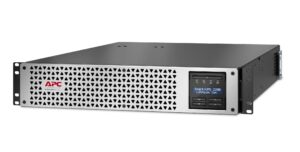Here’s the thing about edge computing ― an edge site can be located just about anywhere, from a small, forgotten closet in an office building to a standalone structure in the nether regions of a vast distributed network supporting an oil and gas operation. Or, it could be under someone’s desk, or even over the desk on the ceiling.
For the most part, these sites run without human interference. They’re remotely monitored and managed to ensure optimal performance and track any attempts at unauthorized use. But first, the equipment has to be installed. And sometimes, like it or not, hardware or uninterruptible power supplies (UPS) must be replaced. Replacements require site visits, which can be especially costly when dealing with hundreds or thousands of sites in large, distributed environments.

Thankfully, a new breed of UPS solutions makes deploying and maintaining your power infrastructure a whole lot easier and more cost-effective. These UPSs are smaller and lighter, delivering substantially higher power density in flexible form factors that make them suitable to various environments, especially at the edge.
Minimize UPS deployment costs at edge computing sites
Here are three ways these new UPS solutions help minimize deployment costs at edge computing sites:
1. Fewer staff needed
The new UPS units feature next-generation semiconductor technology and run on lithium-ion batteries. This enables higher power and energy density in packages smaller than legacy units with valve regulated lead acid (VRLA) batteries. A device that would have weighed 60 pounds or more now is about 35 pounds. That, combined with a smaller size, makes the unit much easier to carry.
So, when deploying the UPS to an edge computing site, be it a building across a university campus or a remote, light industrial location, the lighter, smaller Smart-UPS Ultra takes less effort to install. Traditionally, two people would be necessary for installation, but now it requires only one person, reducing staffing and installation costs.
2. Deployment flexibility
When installing these new Smart-UPS Ultra units, there are more options than with legacy units. While you can still fit them under a desk in a tower orientation, these units can be mounted on a wall or ceiling and take up half the space in a rack where space is tight. This versatility, combined with the smaller footprint, is tailor-made for edge computing or distributed IT environments, making it much easier to install UPSs in confined spaces.
As an added benefit, the unit’s digital display rotates automatically. If you install the device vertically or horizontally, the digits and letters on the display will remain right side up, as they do on a smartphone screen. Traditionally, units would require you to unscrew the display, rotate it, and screw it back on to get the right orientation. Not having to do this saves time and money.
3. Lower total cost of ownership
Lithium-ion batteries last 8-to-10 years – up to three times as long as VRLA batteries, providing a lower total cost of ownership. In most cases, the battery will last as long as the UPS itself, making the UPS essentially maintenance-free because under normal circumstances it requires no battery replacements. In addition to lasting longer, lithium-ion batteries handle many more charge/discharge cycles, making them better suited to distributed environments where the cost of replacing VRLA batteries could be high.
Ready to simplify UPS deployment and maintenance?
Companies need solutions that make it easier to deploy and maintain uninterruptible power across distributed environments and at the edge. Learn more about how Schneider Electric’s new APC Smart-UPS Ultra 3kW single-phase UPSs can help lower costs and increase reliability at your edge sites.



